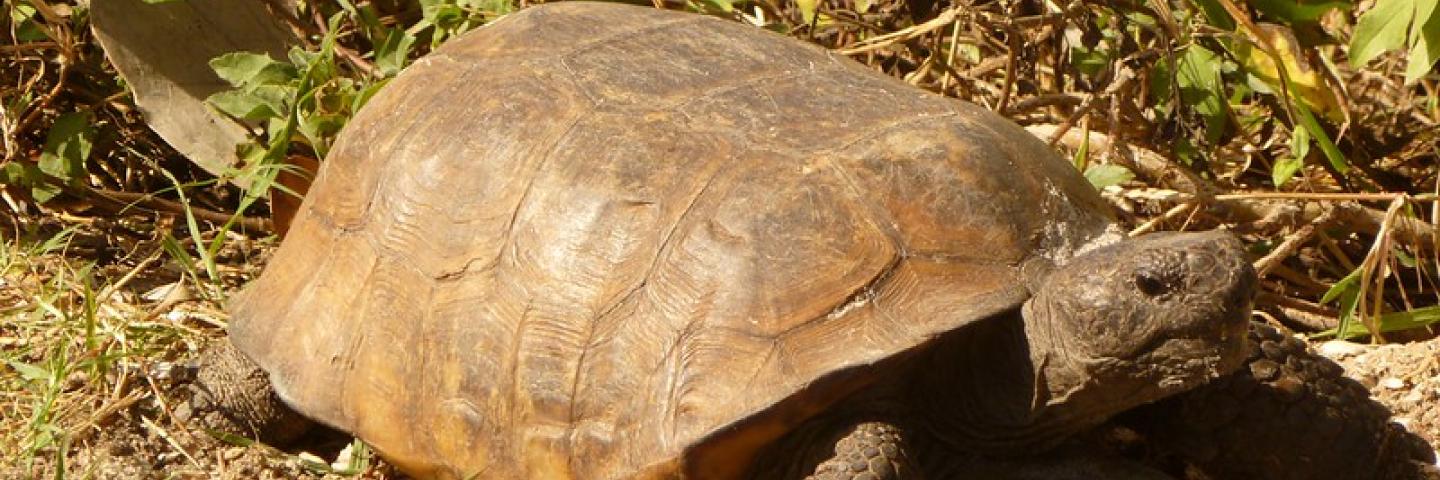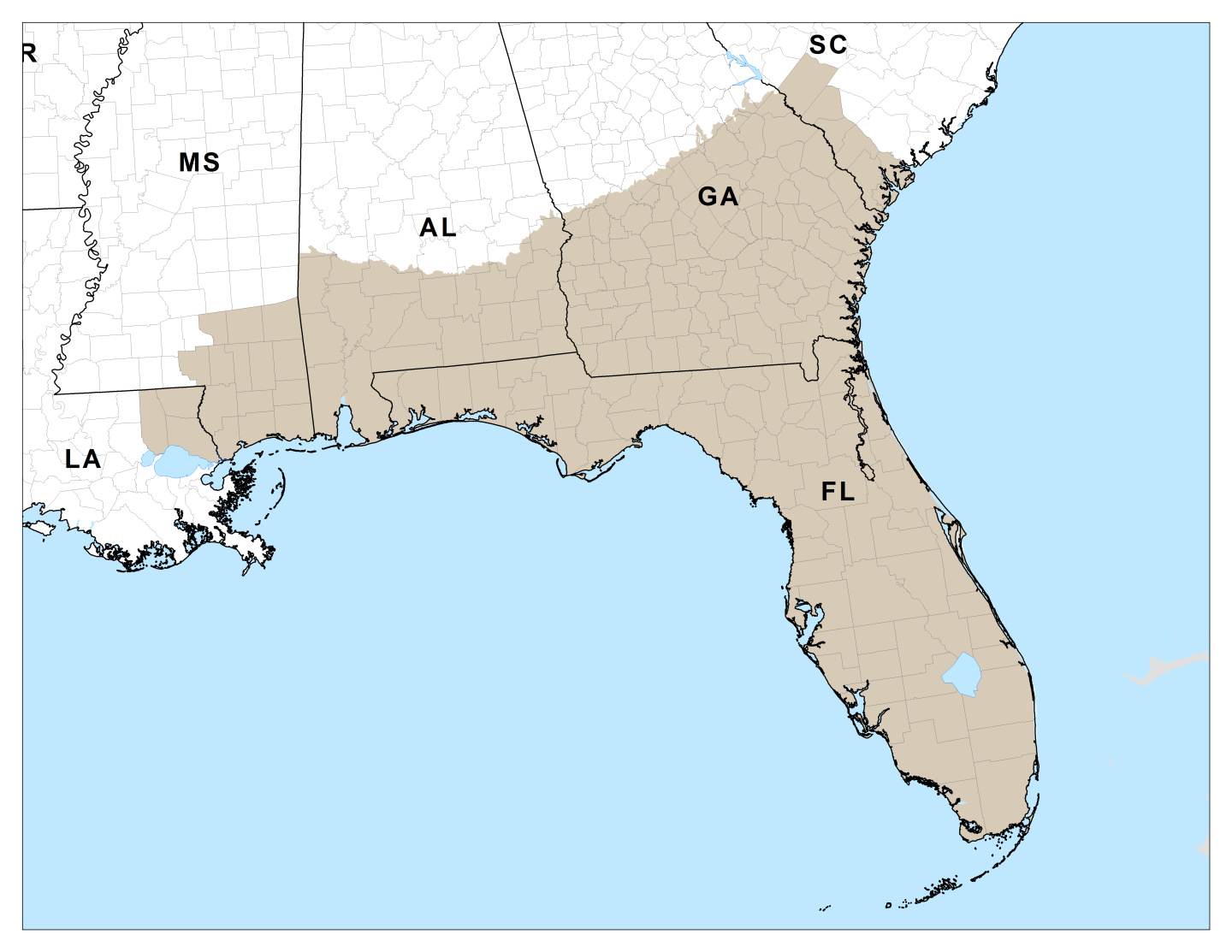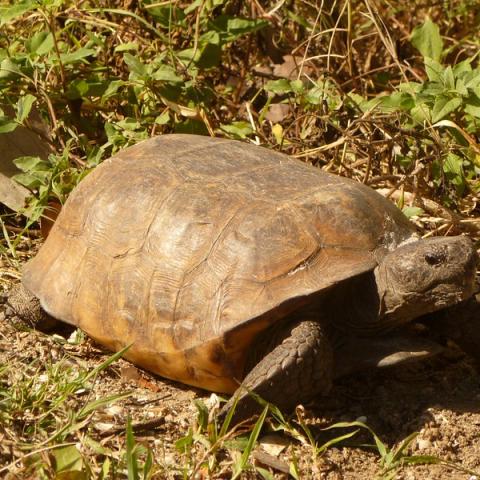
The gopher tortoise is the only land tortoise native to the Southeast, living in longleaf pine savannahs of Louisiana, Mississippi, Alabama, Florida, Georgia and South Carolina.
The gopher tortoise is the only land tortoise native to the Southeast, living in longleaf pine savannahs of Louisiana, Mississippi, Alabama, Florida, Georgia and South Carolina. The gopher tortoise dwells in pine forests with deep, well drained soils and an open understory that provides food and nesting sites.
As its name implies, the gopher tortoise digs burrows of up to 40 feet in length that allow escape from heat and danger. These burrows are a unique feature of southeastern landscapes, harboring many other wildlife species. The gopher tortoise is considered a keystone species of longleaf pine forests, one of the most biologically diverse ecosystems in the world, because its presence supports the stability of many other wildlife populations.
As longleaf pine forests have declined because of development, fire suppression and lack of sound forestry management, gopher tortoise numbers have declined, too. In 1987, the U.S. Fish and Wildlife Service (FWS) listed the gopher tortoise as threatened under the federal Endangered Species Act in the western part of its range (Louisiana, Mississippi and Alabama). In 2011, the FWS determined that the species was a candidate for listing in the rest of its range. However, in October 2022, the FWS announced that listing the gopher tortoise as a threatened or endangered species under the Endangered Species Act (ESA) is not warranted for most of its range. Significantly, the eastern range of the species, which includes Florida, Georgia, South Carolina, and most of Alabama, does not require additional protections under the ESA and will be withdrawn as a candidate for listing. The western range of the species, which includes western Alabama, Mississippi, and Louisiana, will continue to retain its threatened status. This announcement instantly reduces regulatory oversight for millions of landowners across four southeastern states. NRCS continues to work with FWS and other partners to support landowners in restoring sufficient habitat to make expanded federal listing unnecessary, and to provide regulatory peace of mind for land management actions in areas where the species is already listed.

Landowners are part of the solution
More than 80 percent of gopher tortoise habitat is privately owned. Landowners are helping the gopher tortoise by enhancing and restoring longleaf pine forests. With the help of NRCS, landowners are improving forest stands through prescribed burning and other sustainable forestry practices as well as planting new longleaf pine trees. Fires historically burned through the pine savannahs of the South, which suppressed woody species and enabled longleaf pine forests to have an open understory. Prescribed burning mimics that process.
Own or manage land here? You can help.
NRCS offers technical and financial assistance to help agricultural producers voluntarily conserve gopher tortoise habitat on private lands. This assistance helps producers plan and implement a variety of conservation activities, or practices, that benefit the tortoise and support forestry operations.
Technical assistance is free to producers. The agency’s staff of experts and conservation partners work side-by-side with producers to develop a conservation plan. Each plan focuses on the restoration of gopher tortoise habitat and is tailored to the landowner’s property. These plans provide a roadmap for how to use a system of conservation practices to meet natural resource and production goals.
Financial assistance helps producers pay for the adoption of a system of conservation practices that improve the health of forest and grassland ecosystems. NRCS assistance covers part of the cost. This assistance helps landowners improve the health of their forests. Common conservation practices include prescribed burning, timber stand thinning, tree planting and management of invasive plants.
Working Lands for Wildlife
The gopher tortoise is a nationally identified target species of the Working Lands for Wildlife (WLFW) partnership, a collaborative approach to conserve habitat on working lands. Since 2012, WLFW has enabled producers to conserve or create more than 278,000 acres of longleaf pine forests. WLFW provides technical and financial assistance through the Environmental Quality Incentives Program, which is funded through the Farm Bill, the largest funding source for wildlife habitat conservation on private lands. Additionally, NRCS is working to restore longleaf pine across its historic range -- from Texas to Virginia – through the Longleaf Pine Initiative. Since 2010, more than 278,000 acres of forests have been restored or enhanced.
Habitat restored for the gopher tortoise benefits many other species, including red cockaded woodpecker, black pine snake, bobwhite quail, white-tailed deer, turkey and dusky gopher frog. In total, 28 threatened and endangered species are dependent on longleaf pine forests.


